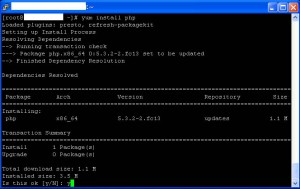 Docker is a popular option for “virtual appliances” nowadays. Docker website defines the “Docker” moniker as a software containerization platform that is more flexible than traditional virtual machines since it virtualizes the operating system instead of the hardware. This means that Docker can further isolate the resources by enabling multiple Docker containers running on an operating system. If the operating system itself is running on a virtual machine either via full virtualization (bare metal) or paravirtualization, we will have a good example of IT infrastructure transformation from asset-ownership model into cloud-lease model (my related paper about such transformation can be read here). Continue reading
Docker is a popular option for “virtual appliances” nowadays. Docker website defines the “Docker” moniker as a software containerization platform that is more flexible than traditional virtual machines since it virtualizes the operating system instead of the hardware. This means that Docker can further isolate the resources by enabling multiple Docker containers running on an operating system. If the operating system itself is running on a virtual machine either via full virtualization (bare metal) or paravirtualization, we will have a good example of IT infrastructure transformation from asset-ownership model into cloud-lease model (my related paper about such transformation can be read here). Continue reading
Category Archives: Linux
Fedora Quick Tip: Resolving Permission Denied Issues in HTTP and FTP services with getsebool and setsebool
 If you are running Fedora Linux as a server, one issue you frequently encounter is strange permission denied error message triggered when you are accessing one of the available network services run on the server. There are a lot of network services to mention, but HTTP and FTP are two good examples of such services. Assume you are trying to access FTP server on your Fedora box. You type the IP address of the server and then supply the username and password. Voila!!! You thought you would be immediately logged in. But instead of seeing the files in your home folder, you are shown an error message. The error message may vary, from something like “Login incorrect for user blah” displayed by Midnight Commander, “500 OOPS: cannot change directory: /home/blah” from Total Commander, to other error messages shown by different FTP client programs.
If you are running Fedora Linux as a server, one issue you frequently encounter is strange permission denied error message triggered when you are accessing one of the available network services run on the server. There are a lot of network services to mention, but HTTP and FTP are two good examples of such services. Assume you are trying to access FTP server on your Fedora box. You type the IP address of the server and then supply the username and password. Voila!!! You thought you would be immediately logged in. But instead of seeing the files in your home folder, you are shown an error message. The error message may vary, from something like “Login incorrect for user blah” displayed by Midnight Commander, “500 OOPS: cannot change directory: /home/blah” from Total Commander, to other error messages shown by different FTP client programs.
If you are 100% sure that you supply the correct user and password information, why couldn’t you get in? Let us assume that you have root access to the server so that you can remotely troubleshoot from the console. This post will give some guide on how you can solve this problem based on common configurations of a Fedora server.
Continue reading
Quick Tip: How to Install and Configure PHP in Fedora Linux
Previously, I have discussed about how to install MySQL on Fedora Linux. In this post, I would like to elaborate PHP installation on Fedora. Even though the installation is simple by nature, I would like to provide some notes to help you troubleshoot some post-installation problems that may occur.
As usual, I will provide the screenshots of the installation along with the commands invoked on the terminal. For the environment, some important settings are written below:
OS : Fedora 13 64-bit
Web server : Apache HTTP Server
PHP version : PHP 5.3.2
Constraints : yum is installed, commands invoked in root shell, Apache is already installed and running
Note: Apache is installed by default in Fedora. You only need to configure and verify that the server is running. How to configure Apache is explained in the online documentation. If you want the server to be public, i.e. accessible from other computers in the network, you should not firewall the HTTP port, which is usually port 80. Also, if you enable selinux, you also need to properly set the flag of some security parameters related to http. I will explain about selinux and http in another post.
Now, let’s move to the installation. Basic installation steps are as follows:
1. Install PHP via yum
root# yum install phpQuick Tip: Installing MySQL on Fedora Linux
 Installing MySQL on Fedora has never been easier than before. If you are a first timer who wants to know how to install MySQL on a Fedora server or desktop, follow this guide to successfully install both MySQL client and server only in three steps.
Installing MySQL on Fedora has never been easier than before. If you are a first timer who wants to know how to install MySQL on a Fedora server or desktop, follow this guide to successfully install both MySQL client and server only in three steps.
Before you proceed to the installation, the environment settings for the snapshot pictures of the installation are provided below:
OS: Fedora 13 64-bit
Prerequisites: yum is installed, commands invoked on root shell
Continue reading
Comprehensive Guide to Java (JRE and JDK) Installation on Fedora Linux – Tips and Tricks
 In this article, you will be exposed to the installation of Sun Java in Fedora Linux. Although Java has been installed by default in every fresh Fedora package, the Java version shipped along with the OS package is the open-source version GNU Java instead. Some applications and frameworks may require Sun Java. Due to licensing issues, however, Sun Java can not be bundled with the default Fedora Linux package and should be installed separately. Although the installation steps in this article can also be reproducible in other Linux distributions, there is no guarantee that steps advised in this article will also work for other Linux distributions.
In this article, you will be exposed to the installation of Sun Java in Fedora Linux. Although Java has been installed by default in every fresh Fedora package, the Java version shipped along with the OS package is the open-source version GNU Java instead. Some applications and frameworks may require Sun Java. Due to licensing issues, however, Sun Java can not be bundled with the default Fedora Linux package and should be installed separately. Although the installation steps in this article can also be reproducible in other Linux distributions, there is no guarantee that steps advised in this article will also work for other Linux distributions.
The installation of Sun Java in a Fedora Linux box can be seamlessly easy. Yet, some people especially those with minimum technical experience on *NIX OSes may face difficulties in completing the installation. This article tries to provide a comprehensive guide for the installation. It provides whole steps to be followed along with corresponding snapshots so that one can accomplish the installation successfully. It also shares some useful tips which may help readers in understanding the environment they are working on better.
Prerequisites and constraints
This installation assumes that the following requirements and constraints have been fulfilled:
1. Installation will be conducted through the console prompt.
2. User conducts the installation using root account.
3. The software yum must have been already installed in the box.
4. The software wget is already installed in the box.
Tip: if wget is not installed yet, run command yum install wget from the console and the software will be immediately installed.
5. Fedora version used is Fedora 8.0 or newer.
Note: in legacy Fedora, there is different path in installing the compatibility libraries. You can check jpackage site for more information.
6. JRE and JDK version to install is 1.6 (snapshots are for JRE and JDK 1.6 update 17)
Continue reading
